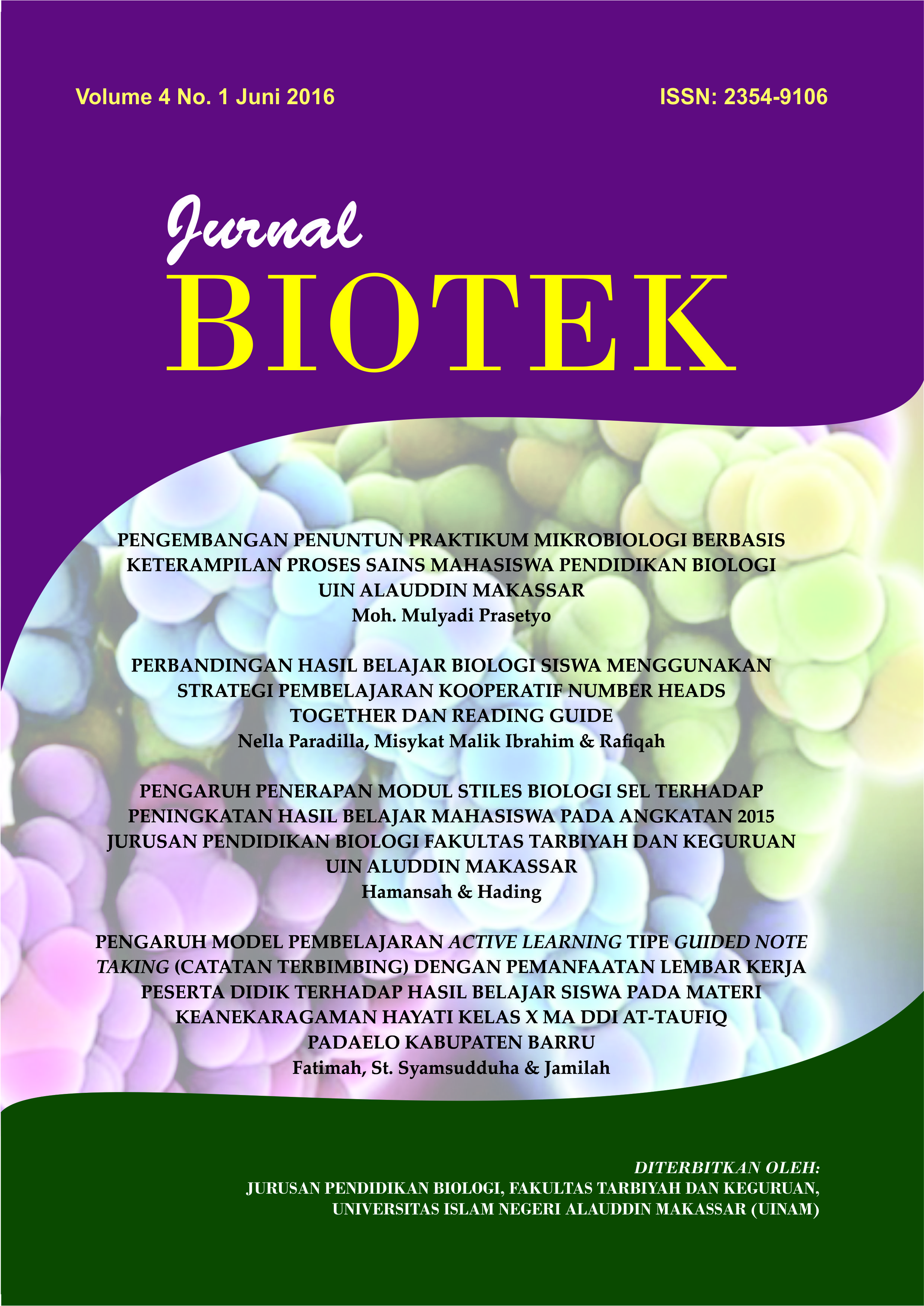PENINGKATAN HASIL BELAJAR MATEMATIKA STANDAR KOMPETENSI LINGKARAN MELALUI METODE KINESTETIK PADA PESERTA DIDIK KELAS VIII.B SMPN 26 SATU ATAP PALLANTIKANG, KECAMATAN MAROS BARU, KABUPATEN MAROS
Abstrak
This study aims to improve learning outcomes mathematics using kinesthetic method. This type of research is a class action (Classroom Action Research). Subject of the study is overall VIII.B grade students of SMPN 26 One Roof Palantikang. Techniques used in data collection study is observation and tests. The results showed that there was an increase in the study of students with the material circles using kinesthetic methods in SMPN 26 One Roof Pallantikang Maros Baru subdistrict. In the first cycle the average value achieved was 64.17 from the ideal value of 100, which is considered low by percentage of completeness 52.2%, and the second cycle the average value achieved was 78 from the ideal value of 100, which is considered high with completeness percentage of 43.5%. This means an increase learners' learning outcomes which affect the increased ability of learners from lower to higher category category after use kinesthetic learning methods.
##plugins.generic.usageStats.downloads##
Referensi
Arikunto, Suharsimi. (2002). Metodologi Penelitian. Penerbit PT. Rineka Cipta. Jakarta
Dimyati dan Mudjiono. (2009). Belajar dan Pembelajaran. Jakarta: PT. Rineka. Cipta
Handayasari, Yayu. (2014). “Model Pembelajaran VAK (Visualization Auditory Kinestetic)”. Online. (Diakses di http://googleweblight.com/?lite_url=http://yayuhandayasari92.blogspot.com/2014/12/model-pembelajaran-vak-visualization.html?m%3D1&ei=AoW9s_FD&lc=id-ID&s=1&m=540&ts=1452919519&sig=ALL1Aj4qTxh8HvsLyqGIgmF_fLvs5BjL9A, pada tanggal 16 januari 2016)
Handoyo, Bekti Hermawan. (2011). Membuat Anak Gemar & Pintar Matematika. Jakarta: Transmedia Pustaka
Manis, Hoeda. (2010). Learning Is Easy. Jakarta: Elex Media Komputindo.
Mustamin, St Hasmiah. (2010). Meningkatkan Hasil Belajar Matematika Melalui Penerapan Asesmen Kinerja. Jurnal Lentera Pendidikan. 13 (1): 33-43.
Nuharini, Dewi, dan Tri Wahyuni. (2008). Matematika Konsep dan Aplikasinya. Jakarta: Hamudha Prima Media
Russel, Lou. (2012). The Accelerated Learning Fieldbook: Panduan Belajar Cepat untuk Pelajar dan Umum. Bandung: Nusa Media.
Sanjaya, Wina. (2006). Strategi Pembelajaran. Jakarta: Kencana
Sembiring, Rosali Br dan Mukhtar. (2013). Strategi Pembelajaran dan Minat Belajar Terhadap Hasil Belajar Matematika. Jurnal Teknologi Pendidikan 6(1): 228.
Suherman, E. et. al. (2001). Strategi Pembelajaran Matematika Kontemporer. Bandung: TIM MKPBM JICA-UPI.
Suherman, E. et. al. (2003). Evaluasi Pembelajaran Matematika. Bandung: TIM MKPBM JICA-UPI.
Sumantoro, dkk. (2007). Silabus. Yogyakarta: Kanisius.
Suprijono, Agus. (2009). Cooperative Learning. Surabaya: Pustaka Pelajar
Uno, Hamzah B. (2006). Perencanaan Pembelajaran. Gorontalo: Bumi Aksara
Authors who publish with Jurnal Biotek agree to the following terms: Authors retain the copyright and grant Universitas Islam Negeri Alauddin Makassar right of first publication with the work simultaneously licensed under a Creative Commons Attribution License (CC BY-SA 4.0) that allows others to share (copy and redistribute the material in any medium or format) and adapt (remix, transform, and build upon the material) the work for any purpose, even commercially with an acknowledgement of the work's authorship and initial publication in Universitas Islam Negeri Alauddin Makassar. Authors are able to enter into separate, additional contractual arrangements for the non-exclusive distribution of the journal's published version of the work (e.g., post it to an institutional repository or publish it in a book), with an acknowledgement of its initial publication in Universitas Islam Negeri Alauddin Makassar. Authors are permitted and encouraged to post their work online (e.g., in institutional repositories or on their website) prior to and during the submission process, as it can lead to productive exchanges, as well as earlier and greater citation of published work (See The Effect of Open Access).

This work is licensed under a Creative Commons Attribution-ShareAlike 4.0 International License.



